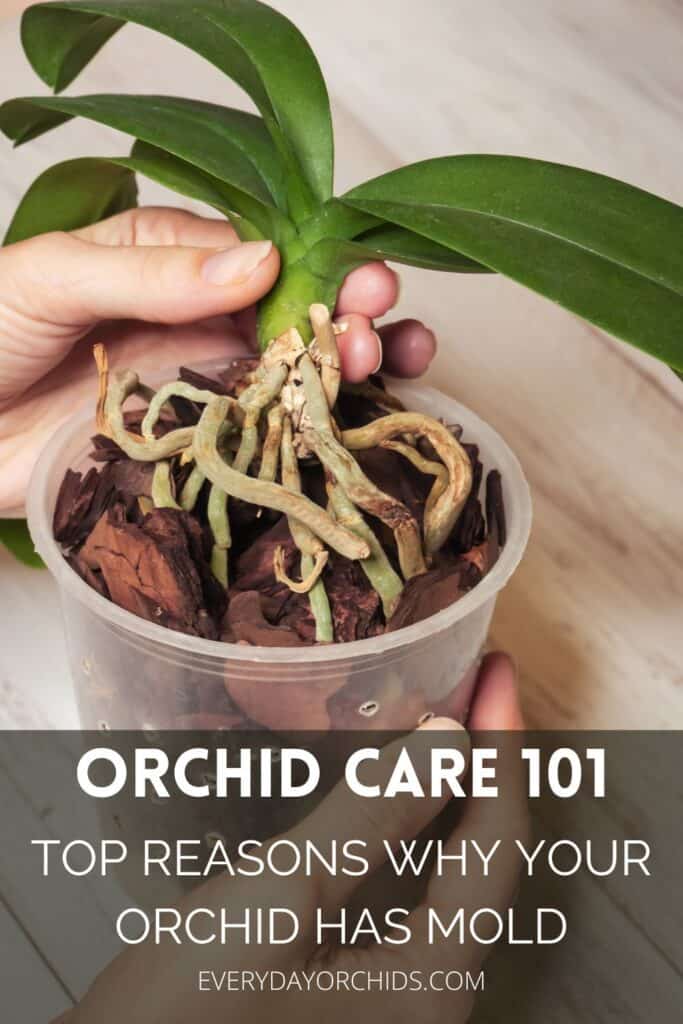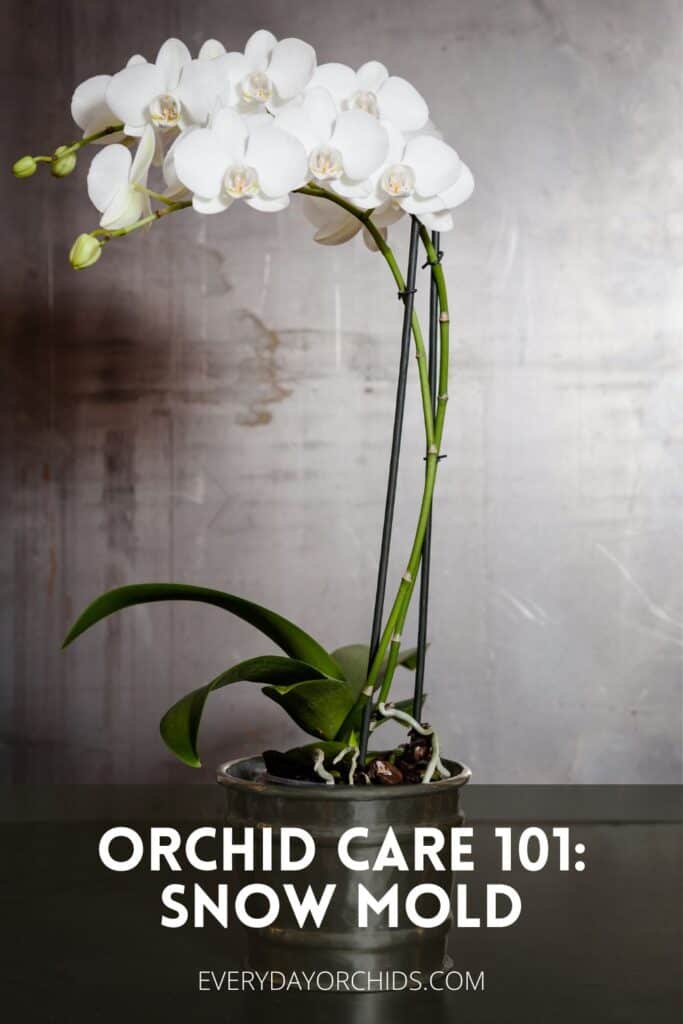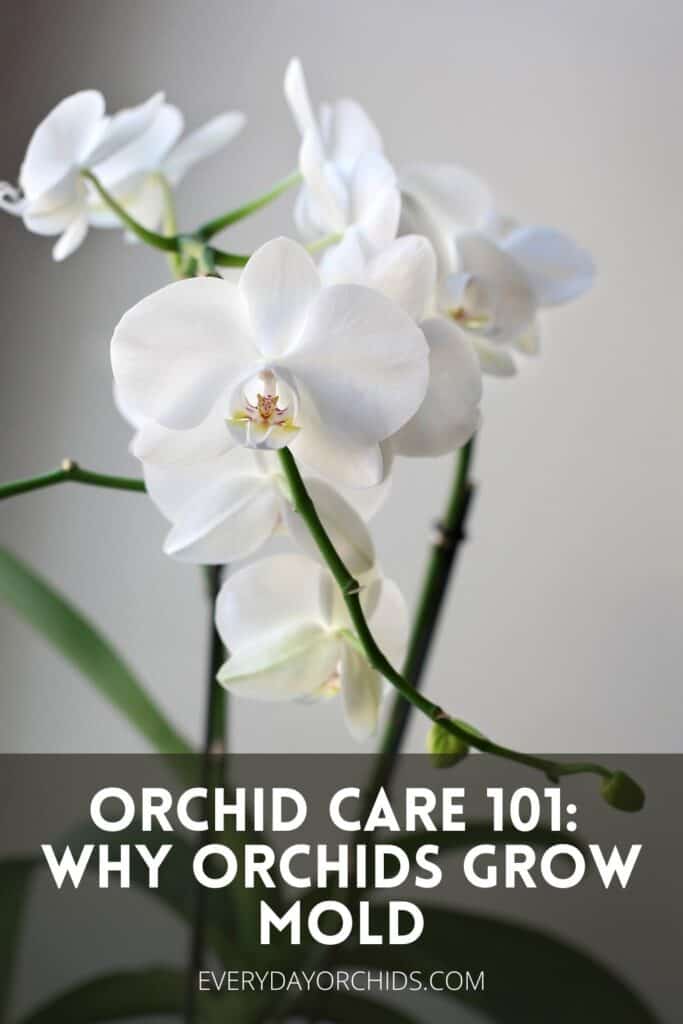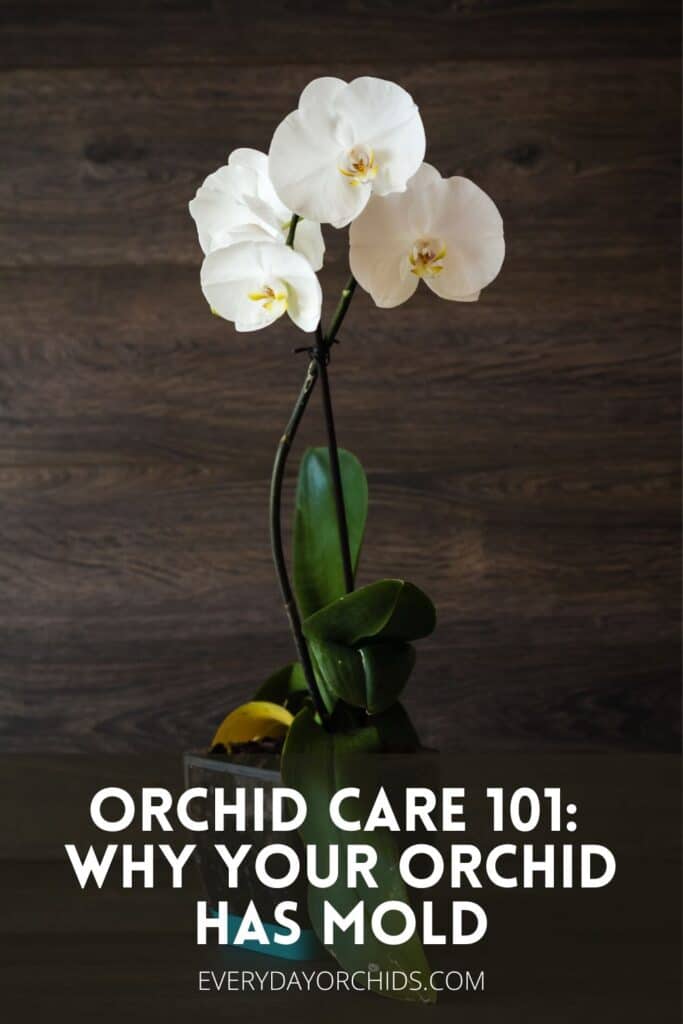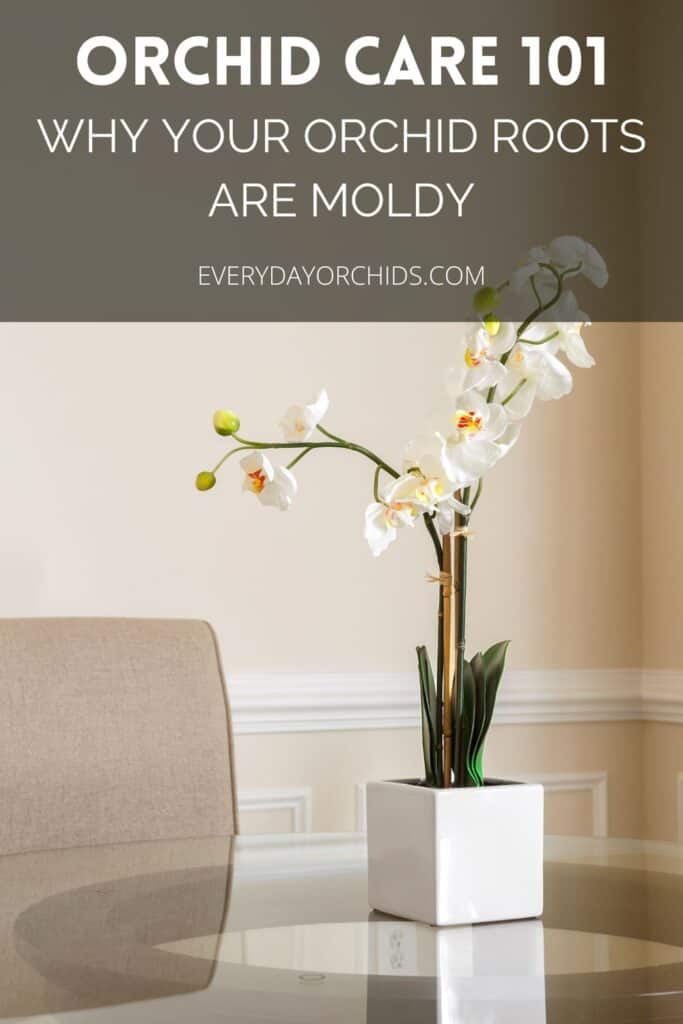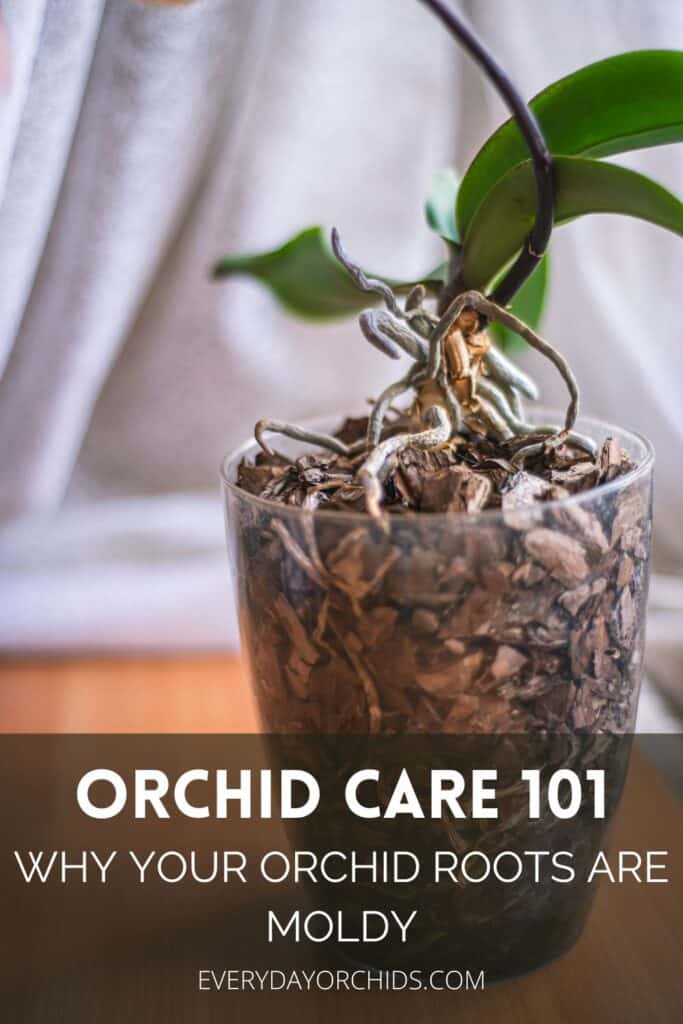Are your orchid roots moldy? If you’ve been caring for orchids for a while, you may have encountered mold growing on the orchid roots or in the potting media at one point or another. Mold on orchid roots or potting media can be a signal that something is wrong with your orchid, the potting media, growing conditions or all of the above.
Mold on orchid roots and potting media can happen due to a number of reasons. If there is high humidity, poor airflow or the potting media does not adequately dry out between waterings, mold can grow. Mold can also appear if you use contaminated potting media.
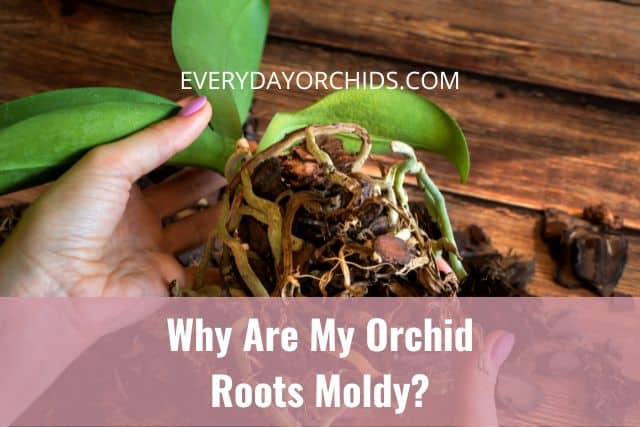
Mold spores are present in the air and environment around us. Given the right growing conditions, mold spores can multiply and grow in and around your orchids. This is the last thing you want to have happen.
Here in this article, I’ll go over why you might find mold on orchid roots or potting media. Keep reading to learn more.
Please note that these links are affiliate links and as an Amazon Associate, I earn from qualifying purchases. Purchases made through affiliate links in this post may generate commissions at no additional cost to you. Use this link for a discounted Amazon Prime trial. Thank you for your support!
Table of Contents
Should You Worry About Mold On The Orchid Potting Media?
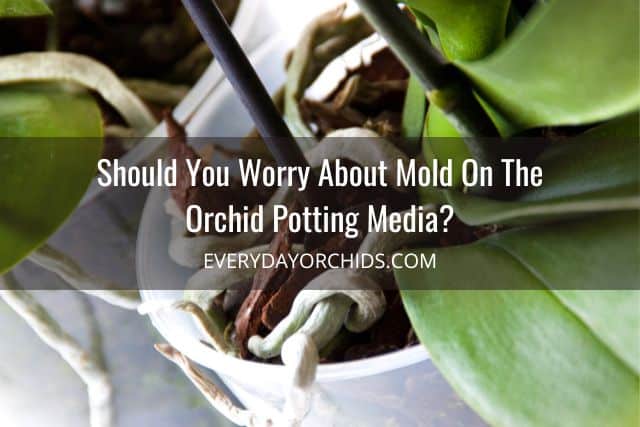
A little bit of mold on the potting media is not always a cause for concern. If the orchid roots are healthy, the presence of mold is not necessarily harmful. However, don’t ignore it.
Orchids can have mold growing in or around the potting media despite appearing healthy. This is due to the presence of environmental factors that allow for mold growth, such as high humidity or poor airflow.
To stop the mold growth, you might just need to adjust your growing practices. This includes making changes such as spacing out the time between waterings or improving airflow around your orchid.
However, when an orchid is sick or already weakened, mold on the orchid potting media can and will be a problem.
The conditions that allowed for mold growth in the first place will allow the mold to spread and eventually cover the orchid roots. As a result, the orchid will become further weakened and more susceptible to other fungi or diseases.
Why Are My Orchid Roots Moldy?
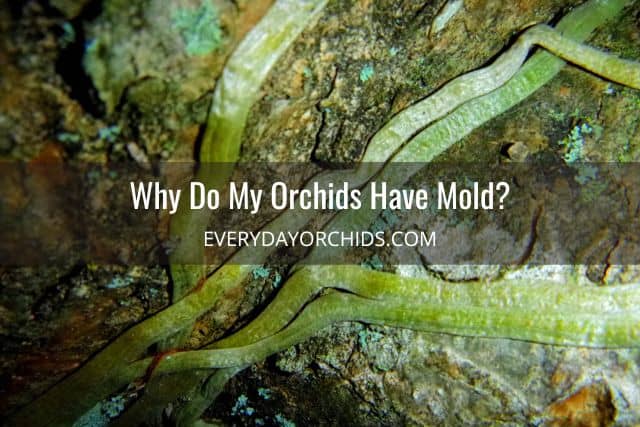
There are a few reasons why you might find mold in and around your orchid. If your orchid roots are moldy, that could be a sign of decomposing potting media or rotting roots. It is a signal that something is wrong in the orchid’s growing environment or with the orchid itself. I’ll go into more detail about these reasons below.
Keep in mind that you’ll typically see mold when something is decomposing or rotting. Mold typically doesn’t appear on healthy orchid roots or orchid potting media that is in good condition.
Also, as a general rule, if the mold is present on the potting media, it is less of a concern compared to when you find mold on the orchid roots.
If your orchid only has a little bit of mold, changing the orchid’s growing conditions could cause the mold on the potting media to eventually go away on its own. However, this is not always guaranteed.
Decaying Or Contaminated Potting Media
Decaying or contaminated potting media is one of the top reasons why you might find mold growing in your orchid pot, particularly if this mold appears after you repot your orchid.
This is because the orchid potting media you bought wasn’t properly sterilized prior to packaging. Mold spores can remain dormant for long periods of time. Sometimes the combination of warm temperatures, poor air flow and damp, humid conditions in the sealed bag allows these mold spores to multiply.
Oftentimes, mold growing on your orchid’s potting media is called snow mold.
Snow mold is a white, powdery mold found on contaminated orchid bark. It is seen in decaying orchid bark and other organic matter. Left unchecked, the snow mold can continue to spread throughout the potting media until it reaches the orchid roots.
If you find that your new bag of orchid potting media has white powder on the orchid bark, toss it out. Buy a new bag of orchid potting media instead.
Wet Potting Media
Another reason why your orchid roots are moldy or mold is growing in potting media is due to the potting media staying wet or damp for long periods of time. In these cases, mold will start to grow.
If your orchid is potted in orchid bark, then be aware that the more often you water your orchid, the faster the potting media will break down and decompose.
Furthermore, if your orchid potting media doesn’t fully dry out between waterings, this can lead to root rot, fungus gnat infestations, and more. This can happen if your orchid is potted in sphagnum moss, but the chances are higher for orchids potted in bark.
Air Currents Or Lack Thereof
Lastly, airflow, or lack thereof, is a major factor in mold growth.
Stagnant air or minimal airflow, combined with warm temperatures and humid or damp conditions, can lead to mold growing in your orchid’s potting media and around the roots.
Other times, mold can be introduced to your orchid via air currents. Mold spores are ever present in the air, invisible to the naked eye. A slight breeze can transmit mold spores from plant to plant. If you grow your orchids outdoors or in a greenhouse, you may encounter this problem more often than indoor orchid growers.
Semi-Hydroponics And Orchids: Mold Problems

Sometimes mold and algae growth can be a problem for orchids grown in semi-hydroponics. The constant moisture, warmth and light create just the right environment for algae to grow. If mold spores are present, the high humidity levels and warmth will encourage mold growth as well.
To address this, try flushing out your semi-hydroponics container often and thoroughly each time you do so. This works best if you have a separate net or basket that your orchid sits in.
Remove the basket from the outer pot and run water through the clay leca pebbles thoroughly. Then, using a mild soap and water, wash the outer pot well and refill with fresh water.
Do not use a fungicide treatment to flush out the semi-hydroponics system in this situation. For extensive mold, you can try a very diluted bleach flush, by creating a solution of 1 ounce bleach in 1 gallon of water. Flush the inner net or basket with this.
To prevent mold from occurring in the first place, make sure that your clay leca pebbles are sanitized before use. As part of my prep method, I clean the leca pebbles in a diluted bleach solution prior to use. Then I rinse them thoroughly before soaking them in water for 24 hours. You can also boil the leca pebbles to sterilize them or heat-sanitize them using a pressure cooker.
Final Thoughts
By itself, mold is not inherently dangerous to an orchid. Rather, mold is a sign of suboptimal orchid growing conditions. Left unchecked, mold growth can eventually weaken an orchid and open the door for more serious fungal infections, diseases or pest infestations to take hold.
In most cases, mold growth on orchid roots or potting media can be attributed to contaminated potting media, overwatering, high humidity and a lack of airflow. Changing your orchid growing practices to avoid these scenarios can help you prevent or address the mold growing on your orchid.
If you enjoyed this article, please pin it and share!

